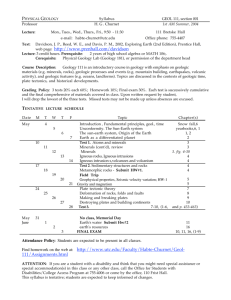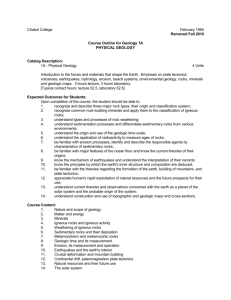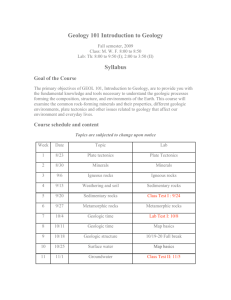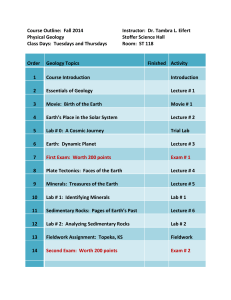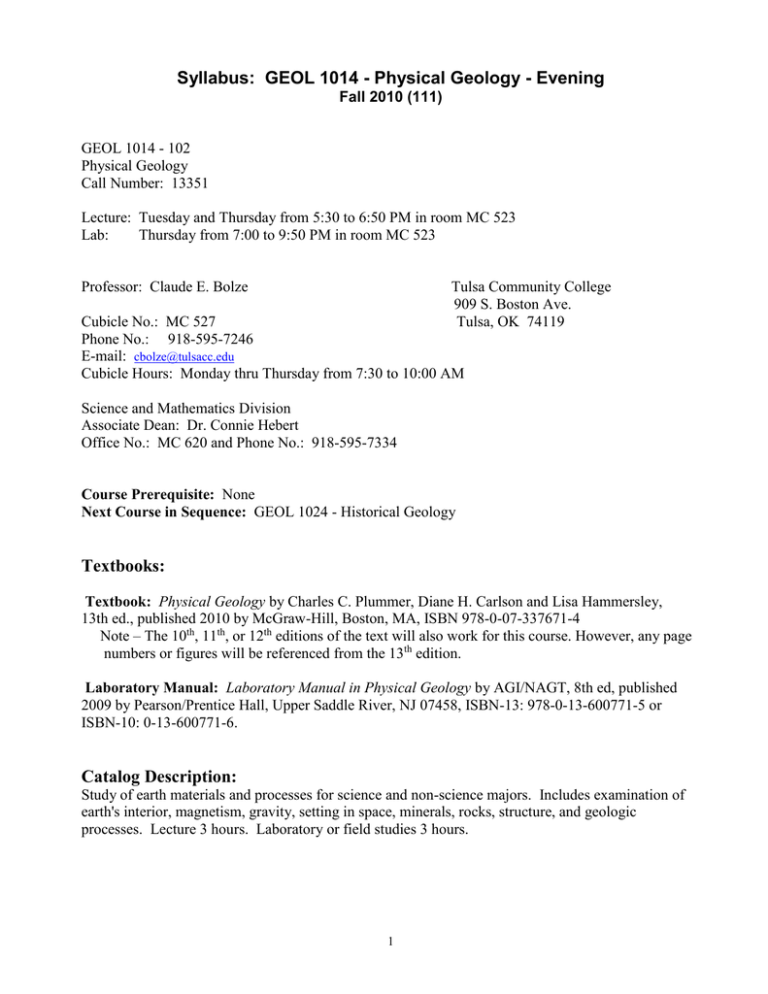
Syllabus: GEOL 1014 - Physical Geology - Evening
Fall 2010 (111)
GEOL 1014 - 102
Physical Geology
Call Number: 13351
Lecture: Tuesday and Thursday from 5:30 to 6:50 PM in room MC 523
Lab:
Thursday from 7:00 to 9:50 PM in room MC 523
Professor: Claude E. Bolze
Tulsa Community College
909 S. Boston Ave.
Tulsa, OK 74119
Cubicle No.: MC 527
Phone No.: 918-595-7246
E-mail: cbolze@tulsacc.edu
Cubicle Hours: Monday thru Thursday from 7:30 to 10:00 AM
Science and Mathematics Division
Associate Dean: Dr. Connie Hebert
Office No.: MC 620 and Phone No.: 918-595-7334
Course Prerequisite: None
Next Course in Sequence: GEOL 1024 - Historical Geology
Textbooks:
Textbook: Physical Geology by Charles C. Plummer, Diane H. Carlson and Lisa Hammersley,
13th ed., published 2010 by McGraw-Hill, Boston, MA, ISBN 978-0-07-337671-4
Note – The 10th, 11th, or 12th editions of the text will also work for this course. However, any page
numbers or figures will be referenced from the 13th edition.
Laboratory Manual: Laboratory Manual in Physical Geology by AGI/NAGT, 8th ed, published
2009 by Pearson/Prentice Hall, Upper Saddle River, NJ 07458, ISBN-13: 978-0-13-600771-5 or
ISBN-10: 0-13-600771-6.
Catalog Description:
Study of earth materials and processes for science and non-science majors. Includes examination of
earth's interior, magnetism, gravity, setting in space, minerals, rocks, structure, and geologic
processes. Lecture 3 hours. Laboratory or field studies 3 hours.
1
Course Objectives:
Physical Geology is designed to accomplish the following objectives:
1. Students develop an appreciation of the workings of geologic processes in their daily lives by
recognizing the following geologic processes: weathering and soils, mass wasting, streams and
floods, waves and coasts, glaciers and glaciation, deserts and wind action and groundwater.
2. Students recognize how the earth works by arranging geologic events in chronological order,
describing volcanoes, locating earthquakes, charting the earth’s interior, diagramming features of
the sea floor, identifying geologic structures and examining plate tectonics.
3. Students identify the common rock forming minerals and classify the common igneous,
metamorphic and sedimentary rocks.
4. Students read and interpret topographic maps with respect to orientation and geologic processes.
5. Students develop a working vocabulary of geologic terms.
Teaching Methods:
Physical Geology is a lecture and lab course. Lectures will generally follow the textbook plan,
although chapter sequences maybe rearranged. Students are expected to read textbook topics before
they are presented in lecture. Students are required to read all assigned textbook chapters.
The laboratory experience is a fundamental part of the course. In lab, students are allowed to gain
hands-on experience with minerals, rocks, and topographic maps. In other words, the lab is designed
to show in a more realistic manner the principles being discussed in lecture. The lab is used to
reinforce the lecture material and demonstrate how it can be practically applied. Most lab periods will
begin with instruction, then students will work through exercises at their own pace. Lab exercises,
while graded, are not tests; therefore, students are encouraged to work together and ask as many
questions as necessary to understand the concepts presented. An understanding of lab exercises will be
directly tested on lecture exams.
Audio-visual aids will be used to supplement the lectures and laboratory activities.
Evaluation Techniques:
Exams:
There will be 4 exams. The final will not be comprehensive. The exams will be a combination of
multiple choice and matching questions. The exams will include lecture, laboratory, and text material.
The 4 exams will comprise 50% of the final grade.
Homework:
There will be 4 homework assignments, one assignment for each exam.
Each question will be worth 2 points. The homework can be handwritten on notebook paper or typed.
The homework assignment will be due the day of the exam. The homework will comprise 20% of the
final grade.
Labs:
Laboratory assignments will be worth 10 points each and are to be handed in at the end of each
laboratory. The lab grade will comprise 30% of the final grade.
2
Attendance Policy: Past experience has shown that regular and prompt attendance is vitally
important for successful completion of this course. Those students who decide not to complete the
course must withdraw themselves from the course. Failure to complete work does not constitute a
withdrawal from Tulsa Community College and those students will receive a grade based upon the
points earned at the end of the semester.
Course Withdrawal: The deadline to withdraw from a course shall not exceed 3/4 the duration
of any class. Contact the Counseling Office at any TCC campus to initiate withdrawal from a course
('W' grade) or to change from Credit to Audit. Check the TCC Academic Calendar for deadlines.
Students who stop participating in the course and fail to withdraw may receive a course grade of “F,”
which may have financial aid consequences for the student.
Communications:
Email communications: All TCC students receive a designated “MyTCC” email address (ex:
bob.buck@mail.tulsacc.edu). All communications to you about TCC and course assignments will be
sent to your MyTCC email address; and you must use MyTCC email to send email to, and receive
email from, the instructor regarding this course.
Inclement Weather: TCC rarely closes. If extreme weather conditions or emergency situations
arise, TCC always gives cancellation notices to radio and television stations. This information is also
posted on the TCC website (www.tulsacc.edu).
General Education Goals: General Education courses at TCC ensure that our graduates gain
skills, knowledge, and abilities that comprise a common foundation for their higher education and a
backdrop for their work and personal lives. TCC’s General Education goals are: Critical Thinking,
Effective Communication, Engaged Learning, and Technological Proficiency.
Classroom Etiquette: Open and mutually respectful communication of varied opinions, beliefs,
and perspectives during classroom or online discussion encourages the free exchange of ideas that is
essential to higher learning and to the ability to learn from each other. Use of any electronic device is
at the discretion of the instructor.
Syllabus Changes: Occasionally, changes to the syllabus may be necessary. Students will be
notified of any changes to the syllabus in writing.
Students with Disabilities: TCC provides accommodations for qualifying students in
compliance with the Americans with Disabilities Act. For information, students may contact the
disabled Student Resource Center, 918-595-7115, or the Resource Center for the Deaf and Hard of
Hearing, 918-595-7428V, 918-595-7434TTY.
Institutional Statement: Each student is responsible for being aware of the information
contained in the TCC Catalog, the TCC Student Policies & Resources Handbook, and semester
information listed in the class schedule. All information may be viewed on the TCC website:
www.tulsacc.edu
3
Academic Dishonesty: Academic dishonesty (cheating) is defined as the deception of others
about one’s own work or about the work of another. Academic dishonesty or misconduct is not
condoned or tolerated at campuses within the Tulsa Community College system. Tulsa Community
College adopts a policy delegating certain forms of authority for disciplinary action to the faculty.
Such disciplinary actions delegated to the faculty include, but are not limited to, the dismissal of
disrespectful or disorderly students from classes. In the case of academic dishonesty a faculty member
may:
Require the student to redo an assignment or test, or require the student to complete a
substitute assignment or test;
Record a "zero" for the assignment or test in question;
Recommend to the student that the student withdraw from the class, or administratively
withdraw the student from the class;
Record a grade of "F" for the student at the end of the semester.
Faculty may request that disciplinary action be taken against a student at the administrative level by
submitting such request to the Dean of Student Services.
Grade Scale
Grade Distribution
90 - 100%
80 - 89%
70 - 79%
60 - 69%
Exams
= 50%
Homework = 20%
Lab Exercises = 30%
=A
=B
=C
=D
Late Assignments and Make-up Test Policy:
Exams:
Exams may be made-up at the instructor's convenience. Make-up exams will be more rigorous.
Homework:
Homework will be accepted late, however, 2 points will be deducted from the grade for each class
meeting the homework is late.
Labs:
There will be no make-up for labs involving the use of lab equipment. However, a take home lab
worth half credit can be arranged at the student's request. Labs not involving the use of lab equipment
will be accepted late, however, 2 point will be deducted from the grade for each class meeting the
assignment is late.
Last day to withdraw with a "W" grade: Friday, November 5.
4
Tentative Schedule - Lecture
August 17 – September 16: The Earth's Composition.
Chapters 1, 2, 3, 4, 5, 6, 7.
September 21 Homework #1 due and Exam #1.
September 23 – October 12: The Earth's Structure and Internal Processes.
Chapters 15, 16, 17, 18, 19.
October 14 Homework #2 due and Exam #2.
October 19 – November 4: The Earth's Surface Processes.
Chapters 11, 12, 13.
November 9 Homework #3 due and Exam #3.
November 11 – December 2: Additional Topics in Physical Geology.
Chapters 8, 9, 10, 20, 22.
December 7 Homework #4 due and Exam #4 - Final.
September 6: No Class – Labor Day.
November 24 – November 28: No Class – Thanksgiving.
Tentative Schedule - Laboratory
Week
1
2
3
4
5
6
7
8
9
11
12
13
14
15
16
Date
August 19
August 26
September 2
September 9
September 16
September 23
September 30
October 7
October 14
October 21
October 28
November 4
November 11
November 18
December 2
Laboratory
Topographic Maps and Aerial Photographs.
Mineral Properties and Identification.
Igneous Rocks and Volcanic Hazards.
Sedimentary Rocks and Environments.
Metamorphic Rocks and Processes.
Downtown Geology Field Trip
Earthquake Hazards and Human Risks.
Plate Tectonics and the Origin of Magma.
No Lab.
Groundwater Processes and Resources.
Dryland Landforms, Hazards, and Risks.
Glacial Processes and Landforms.
Dating Rocks, Fossils and Geologic Events.
Stream Processes and Landscapes.
Subsurface Geology and Fossil Fuel Exploration.
Laboratory Manual: Laboratory Manual in Physical Geology by AGI/NAGT, 8th ed, published
2009 by Pearson/Prentice Hall, Upper Saddle River, NJ 07458, ISBN-13: 978-0-13-600771-5 or
ISBN-10: 0-13-600771-6.
Note: This Syllabus and Schedule are subject to change. Students will receive in writing any changes
to this Syllabus and Schedule.
5
Physical Geology Schedule - Evening
Fall 2010 (111)
Tues
8/17
Syllabus.
Introduction to Physical Geology, 1: 2-27.
1
Thur 8/19 Atoms, Elements, and Minerals, 2: 28-41.
Lab - Topographic Maps and Aerial Photographs – pp. 167-194.
Tues 8/24 Physical Properties of Minerals, 2: 41-53.
Rock Cycle, 3: 56-58.
2
Thur 8/26 Intro to Igneous Rocks, 3: 54-64 & 4: 82-95.
Volcanoes, 4: 95-111. Mount St. Helens, Box 4.1, 86.
Lab - Mineral Properties, Uses, and Identification – pp. 47-74.
Tues 8/31 Chemistry and Classification of Igneous Rocks, 3: 58-64 & 4: 91-95.
Origin of Magma, 3: 67-81. Intrusive Rock Bodies, 3: 65-67.
Thur 9/2
Movie – Return to Mount St. Helens.
Lab - Igneous Rocks and Volcanic Hazards – pp. 89-108.
Tues 9/7
Weathering and Soils, 5: 112-135.
Thur 9/9
Types of Sedimentary Rocks, 6: 143-152.
Formation of Sedimentary Rocks, 6: 136-143.
Lab - Sedimentary Rocks, Processes, and Environments – pp. 109-132.
3
4
Tues 9/14 Sedimentary Structures and Interpretation of Sedimentary Rocks, 6: 152-167.
5
Thur 9/16 Metamorphic Rocks, 7: 168-191.
Review for Exam #1.
Lab - Metamorphic Rocks, Processes, and Resources – pp. 133-150.
Tues 9/21 Homework #1 due and Exam #1.
Chapters 1, 2, 3, 4, 5, 6, 7.
6
Thur 9/23 Review Exam.
Earthquakes, 16: 406-441.
Lab – Downtown Geology Field Trip.
6
Tues 9/28 Earthquakes.
7
Thur 9/30 Earth’s Interior and Geophysical Properties, 17: 442-465.
Lab - Earthquake Hazards and Human Risks – pp. 297-308.
Tues 10/5 The Sea Floor, 18: 466-489.
8
Thur 10/7 Plate Tectonics 19: 490-525.
Lab - Plate Tectonics and the Origin of Magma – pp. 30-46.
Tues 10/12 Geologic Structures, 15: 382-405.
Review for Exam #2
9
Thur 10/14 Homework #2 due and Exam 2.
Chapters 15, 16, 17, 18, 19.
Lab – No Lab.
Tues 10/19 Groundwater, 11: 282-305.
10
Thur 10/21 Caves, 11: 297-300.
Lab - Groundwater Processes, Resources, and Risks – pp. 236-250.
Tues 10/26 Deserts and Wind Action, 13: 338-359.
11
Thur 10/28 Deserts and Wind Action.
Lab - Dryland Landforms, Hazards, and Risks – pp. 270-283.
Tues 11/2 Glaciers and Glaciation, 12: 306-316.
12
Thur 11/4 Glaciers and Glaciation, 12: 316-337.
Review for Exam #3.
Lab - Movie: Rise and Fall of the Great Lakes and
Glacial Processes, Landforms, and Indicators of Climate Change – pp. 251-269.
Tues 11/9 Homework #3 due and Exam #3.
Chapters 11, 12, 13.
13
Thur 11/11 Review Exam.
Origin of the Earth, 22: 584-596. Time and Geology, 8: 192-219.
Lab - Dating of Rocks, Fossils, and Geologic Events – pp. 151-166.
7
Tues 11/16
Streams and Landscapes, 10: 246-254.
14
Thur 11/18 Streams and Landscapes, 10: 254-281.
Lab - Stream Processes, Landscapes, Mass Wastage, and Flood Hazards – pp. 213-235.
Tues 11/23 Movie: Mass Wasting.
Mass Wasting, 9: 220-245.
15
Wed 11/24 – Sun 11/28 No Class - Thanksgiving
Tues 11/30 Mass Wasting, 9: 220-245.
Thur 12/2
16
Mountain Belts and the Continental Crust, 20: 526-549.
Review for Exam #4.
Lab – Subsurface Geology and Fossil Fuel Exploration.
Tues 12/7 Homework #4 due and Exam #4.
Chapters 8, 9, 10, 20, 22.
17
How to Calculate Physical Geology Grade
Grade Scale
90 - 100%
80 - 89%
70 - 79%
60 - 69%
Grade Distribution
=A
=B
=C
=D
Exams
= 50%
Homework
= 20%
Lab Exercises = 30%
Your Exam Points x 0.5 = Exam Points
Possible Points
Your Homework Points x 0.2 = Homework Points
Possible Points
Your Lab Points
Possible Points
x
0.3 = Lab Points
Extra Credit is added to only Your Points and are not added to the Possible Points.
Grade = (Exam Pts + Homework Pts + Lab Pts) x 100
8
Homework Assignments - Evening
Each question is worth 2 points.
Homework #1 - due September 21. The Earth's Composition.
Chapter 2 - Atoms, Elements, and Minerals.
1 (4). Define the following pairs of terms: silica, silicate, silicon, silicon-oxygen tetrahedron.
2 (9). What are the three most common elements (percentage by weight) in the earth's crust?
Chapter 3 - Igneous Rocks.
3 (1). Why do mafic magmas tend to reach the surface much more often than silicic (felsic) magmas?
4 (4). How would you distinguish, on the basis of minerals present, among granite, gabbro, and diorite?
5 (8). What is the difference between feldspar found in gabbro and feldspar found in granite?
Chapter 4 - Volcanism and Extrusive Rocks.
6 (3). What do pillow structures indicate about the environment of volcanism?
7 (5). What property (or characteristic) of obsidian makes it an exception to the usual geologic
definition of rock?
8 (9). Why are extrusive igneous rocks fine-grained?
Chapter 5 - Weathering and Soil.
9 (1). Why are some minerals stable several kilometers underground but unstable at the earth's
surface?
10 (6). How can mechanical weathering speed up chemical weathering?
Chapter 6 - Sedimentary Rocks.
11 (3). What do mud cracks tell about the environment of deposition of a sedimentary rock?
12 (7). Describe three different origins of limestone.
13 (11). How do evaporites form? Name two evaporites.
Chapter 7 - Metamorphic Rocks.
14 (2). What are the various sources of heat for metamorphism?
15 (3). How do regional metamorphic rocks differ in texture from contact metamorphic rocks?
Extra Credit (2 pts each).
Chapter 3 - Igneous Rocks.
16 (7). Why is a higher temperature required to form magma at the oceanic ridges than in the
continental crust?
Chapter 5 - Weathering and Soil.
17 (4). Why do stone buildings tend to weather more rapidly in cities than in rural areas?
9
Homework #2 - due October 14. The Earth's Structure and Internal Processes.
Chapter 15 - Geologic Structures.
1 (3). On a geologic map, if no cross section were available, how could you distinguish an anticline
from a syncline?
2 (6). What is the difference between strike, direction of dip, and angle of dip?
Chapter 16 - Earthquakes.
3 (2). What causes earthquakes?
4 (3). Compare and contrast the concepts of intensity and magnitude of earthquakes?
5 (11). What are aftershocks?
Chapter 17 - The Earth's Interior.
6 (3). What facts make it probable that the earth's core is composed of mostly iron?
7 (4). Describe the differences between continental crust and oceanic crust.
8 (10). What is the Mohorovicic discontinuity?
9 (11). What is the asthenosphere? Why is it important?
Chapter 18 - The Sea Floor.
10 (7). Describe two different origins for the continental rise?
11 (10). Describe the two main types of sea-floor sediment.
12 (11). How does the age of sea-floor rocks compare with the age of continental rocks? Be specific.
Chapter 19 - Plate Tectonics.
13 (5). What is Pangaea?
14 (7). How does sea-floor spreading account for the age of the sea floor?
15 (8). What is a plate in the concept of plate tectonics?
Extra Credit (2 pts each).
Chapter 16 - Earthquakes.
16 (7). Describe several techniques that may help scientists predict earthquakes.
Chapter 1 - Introduction to Physical Geology.
17 (6). What would the surface of the earth be like if there were no tectonic activity?
10
Homework #3 - due November 9. The Earth's Surface Processes.
Chapter 11 - Groundwater.
1 (4a). What chemical conditions are necessary for caves to develop in limestone?
(4b). For stalactites to develop in a cave?
2 (6). Describe several ways in which groundwater can become polluted.
3 (12). How does petrified wood form?
4 (14). How does a confined aquifer differ from an unconfined aquifer?
Chapter 12 - Glaciers and Glaciation.
5 (2). How do features caused by stream erosion differ from features caused by glacial erosion?
6 (4). Why is the North Pole not glaciated?
Chapter 13 - Deserts and Wind Action.
7 (1). What are two reasons why parts of the southwestern United States have an arid climate?
8 (5). Give two reasons why wind is a more effective agent of erosion in a desert than in a humid
region.
Extra Credit (2 pts each).
Chapter 11 - Groundwater.
9 (10). What controls the velocity of groundwater flow?
11
Homework #4 - due December 7. Additional Topics in Physical Geology.
Chapter 8 - Time and Geology.
1 (2). Suppose you had a radioactive isotope X whose half-life in disintegrating to daughter product Y
is 120,000 years. By calculating how much it took to make the present amount of Y, you
determine that originally, the rock contained 8 grams of isotope X. At present only 1/4 gram of
X is in the rock.
a. How many half-lives have gone by?
b. How old is the rock?
Chapter 22 – The Earth Companions.
2 (6). Why is the Earth much less cratered than the moon?
Chapter 9 - Mass Wasting.
3 (1). Describe the effect on shear strength of the following:
a. slope angle
b. orientation of planes of weakness
c. water in soil
d vegetation
4 (5). Why is solifluction more common in colder climates than in temperate climates?
Chapter 10 - Streams and Floods.
5 (1). What factors control a stream's velocity?
6 (3). In what part of a large alluvial fan is the sediment the coarser? Why?
7 (4). What does a trellis drainage pattern tell about the rocks underneath it?
8 (12). What is base level?
Chapter 20 - Mountain Belts and Continental Crust.
9 (1). What does a fold and thrust belt tell us about what occurred during an orogeny?
10 (3). Explain how erosion and isostasy eventually produce stable, relatively thin, continental crust.
Extra Credit (2 pts each).
Chapter 10 - Streams and Floods.
11 (10). Name and describe the three main ways in which a stream transports sediment.
Chapter 1 - Introduction to Physical Geology.
12 (7). Explain why caveman never saw a dinosaur.
12


